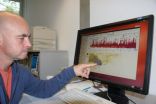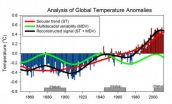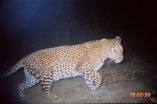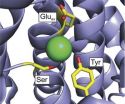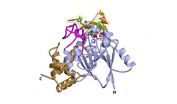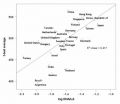The ozone hole has stabilized -- some questions remain
Ozone report of the United Nations
2014-09-11
(Press-News.org) After the detection of the ozone-depleting properties of CFCs in the 1970s, data from satellite measurements in 1985 startled mankind. A huge hole had been discovered over the Antarctic in the ozone layer that protects the Earth from dangerous, carcinogenic UV rays. Already in 1987 politicians around the world reached agreement on the Montreal Protocol that bans ozone-depleting substances, in particular chlorofluorocarbons (CFCs). 197 states have now ratified this international treaty. A series of scientific expert reports has since accompanied the efforts to save the ozone layer. The eighth in the series of these reports was published on 10 September 2014 at a joint press conference of WMO (World Meteorological Organization) and UNEP (United Nations Environment Program). As one of the lead authors Empa scientist Stefan Reimann made a major contribution.
Ozone layer returning to its 1980 levels
The Antarctic ozone hole continues to appear every September. But unlike in the 1980s and 1990s it is no longer growing. Since the turn of the millennium it has remained unchanged. There are even signs of a slow recovery. Model calculations reveal that by 2050 the ozone layer may have returned to its 1980 levels. The concentration of most ozone depleting substances (mainly CFCs) mentioned in the Montreal Protocol has fallen as expected. This is monitored in measurements over many years, amongst other things, on Jungfraujoch. The global emissions of HCFCs, introduced as replacements but which are just as harmful to the ozone layer, have stabilized on a high level and are expected to fall in the future.
Now, surprisingly "new" CFCs have been discovered in the atmosphere, which have never been produced on an industrial scale, smaller amounts of which may nonetheless escape as industrial by-products. The concentration of these substances is, however, between 100 and 1,000 times lower than the classic ozone depleting substances. The fact that these substances can be traced shortly after they have been released highlights the capabilities of global measurement networks. The measurement networks act like early warning systems and ensure that emissions of potentially hazardous substances can be identified as early as possible. CFCs used in the past, for instance, in insulating foams and cooling systems still pose a significant threat to the ozone layer, though. During the recycling of these systems, it is important to collect CFCs separately and destroy them by incineration; otherwise this legacy of the past would harm the ozone layer more than all new substances together.
Whereas the classical ozone depleting substances are thus slowly disappearing, the volume of hydrofluorocarbons (HFCs), the replacement for ozone-depleting substances, is increasing by around 7 percent a year. These substances do not harm the ozone layer but they often have a high greenhouse potential and contribute markedly to global warming. They, too, should be replaced in future. There are open questions, too, about the replacement substances supposed to mitigate the greenhouse effect. HFO-1234yf, for example, is intended to be used in AC system of new cars. This substance decomposes in the atmosphere into trifluoroacetic acid – a compound that is not degraded in nature and, therefore, accumulates in the environment.
Worrying deviations discovered
During the regular monitoring of trace gas data from the global measurement networks, the atmospheric researchers noticed significant deviations. These findings are also mentioned in the latest UNEP report. For instance, the concentration of the ozone-depleting gas carbon tetrachloride is not falling by four percent (as predicted) but by only one percent – although production of this substance is only allowed as intermediate, with very small expected emissions. New measurement data indicate that the emissions do not come from Europe or North America.
INFORMATION:
Reference
Scientific Assessment of Ozone Depletion, World Meteorological Organization, Geneva, Switzerland, 2014
ELSE PRESS RELEASES FROM THIS DATE:
Crop improvement and resistance to pathogens benefits from non-coding RNA studies
2014-09-11
With the rise of emerging economies around the world and a concomitant upgrade of health care systems, the global population has been rapidly expanding. As a consequence, worldwide demand for agricultural products is also growing.
Crops now provide food and the other important resources for seven billion humans.
Food supplies are primarily based on such crops as wheat, maize, rice and vegetables. But as the area of arable land and of cultivated land continues to decline, the future ability to meet the world's food security needs has come under a cloud of uncertainty.
Meanwhile, ...
Last decade's slow-down in global warming enhanced by an unusual climate anomaly
2014-09-11
A hiatus in global warming ongoing since 2001 is due to a combination of a natural cooling phase, known as multidecadal variability (MDV) and a downturn of the secular warming trend. The exact causes of the latter, unique in the entire observational record going back to 1850, are still to be identified, according to an article by the European Commission's Joint Research Centre (JRC).
The earth hasn't warmed at the same pace during the 20th century. The noticeable temperature increases during some periods interspersed with fairly stable or decreasing levels during others ...
The quantum revolution is a step closer
2014-09-11
Theories show how computing devices that operate according to quantum mechanics can solve problems that conventional (classical) computers, including super computers, can never solve. These theories have been experimentally tested for small-scale quantum systems, but the world is waiting for the first definitive demonstration of a quantum device that beats a classical computer.
Now, researchers from the Centre for Quantum Photonics (CQP) at the University of Bristol together with collaborators from the University of Queensland (UQ) and Imperial College London have increased ...
VALUE study reports on accreditation status
2014-09-11
SEPTEMBER 2014 | Ellicott City, MD – The Intersocietal Accreditation Commission (IAC) announced today that researchers from the University of Miami Miller School of Medicine have published a manuscript in Vascular Medicine analyzing a random national sample of Medicare beneficiary data to determine the outpatient vascular testing facilities' accreditation status and geographic location. The study manuscript entitled, "Accreditation Status and Geographic Location of Outpatient Vascular Testing Facilities Among Medicare Beneficiaries: The VALUE (Vascular Accreditation, Location ...
Bully victims more likely to suffer night terrors and nightmares by age 12
2014-09-11
Children who are bullied at ages 8-10 are more likely to suffer from sleep walking, night terrors or nightmares by the time they are 12 years old.
In a study published this week in Pediatrics, journal of the American Pediatric Association, Professor Dieter Wolke and Dr Suzet Tanya Lereya from the University of Warwick, found being bullied increases the risk for a category of sleep disorders known as parasomnias. These are sleep-related problems such as nightmares, night terrors or sleep walking.
A cohort of children from the Avon Longitudinal Study of Parents and Children ...
Study: Cat bites dog
2014-09-11
NEW YORK (September 11, 2014) – A new study led by the Wildlife Conservation Society reveals that in India's human dominated agricultural landscapes, where leopards prowl at night, it's not livestock that's primarily on the menu – it is man's best friend.
The study, which looked at scat samples for leopards in India's Ahmednagar's district in Maharashtra, found that 87 percent of their diet was made up of domestic animals. Domestic dog dominated as the most common prey item at 39 percent and domestic cats were second at 15 percent.
Seventeen percent of the leopard's ...
Is the pattern of brain folding a 'fingerprint' for schizophrenia?
2014-09-11
Philadelphia, PA, September 11, 2014 – Anyone who has seen pictures or models of the human brain is aware that the outside layer, or cortex, of the brain is folded in an intricate pattern of "hills", called gyri, and "valleys", called sulci.
It turns out that the patterns of cortical folding are largely consistent across healthy humans, broadly speaking. However, disturbances in cortical folding patterns suggest deeper disturbances in brain structure and function.
A new study published in the current issue of Biological Psychiatry suggests that schizophrenia is associated ...
How bacteria battle fluoride
2014-09-11
He's not a dentist, but Christopher Miller is focused on fluoride. Two studies from his Brandeis University lab provide new insights into the mechanisms that allow bacteria to resist fluoride toxicity, information that could eventually help inform new strategies for treating harmful bacterial diseases. The studies appear in The Journal of General Physiology (JGP).
Although most animal cells are protected from direct exposure to fluoride, this toxic element is a serious threat to single-celled organisms like bacteria and yeast. As a result, their plasma membranes carry ...
Structure of enzyme seen as target for ALS drugs
2014-09-11
VIDEO:
In this movie, the Dbr1 enzyme rotates 360 degrees. Partially inhibiting Dbr1 could represent a new way to treat most cases of amyotrophic lateral sclerosis (ALS), according to a new...
Click here for more information.
SAN ANTONIO, Texas, U.S.A. (Sept. 10, 2014) — Investigators from the School of Medicine at The University of Texas Health Science Center at San Antonio have determined the first high-resolution structure of an enzyme that, if partially inhibited, could represent ...
Hold the mayo
2014-09-11
You are what you eat, the saying goes, and now a study conducted by researchers at UC Santa Barbara and the University of Pittsburgh suggests that the oft-repeated adage applies not just to physical health but to brain power as well.
In a paper published in the early online edition of the journal Prostaglandins, Leukotrienes and Essential Fatty Acids, the researchers compared the fatty acid profiles of breast milk from women in over two dozen countries with how well children from those same countries performed on academic tests.
Their findings show that the amount of ...
LAST 30 PRESS RELEASES:
Survey reveals ethical gaps slowing AI adoption in pediatric surgery
Stimulant ADHD medications work differently than thought
AI overestimates how smart people are, according to HSE economists
HSE researchers create genome-wide map of quadruplexes
Scientists boost cell "powerhouses" to burn more calories
Automatic label checking: The missing step in making reliable medical AI
Low daily alcohol intake linked to 50% heightened mouth cancer risk in India
American Meteorological Society announces Rick Spinrad as 2026 President-Elect
Biomass-based carbon capture spotlighted in newly released global climate webinar recording
Illuminating invisible nano pollutants: advanced bioimaging tracks the full journey of emerging nanoscale contaminants in living systems
How does age affect recovery from spinal cord injury?
Novel AI tool offers prognosis for patients with head and neck cancer
Fathers’ microplastic exposure tied to their children’s metabolic problems
Research validates laboratory model for studying high-grade serous ovarian cancer
SIR 2026 delivers transformative breakthroughs in minimally invasive medicine to improve patient care
Stem Cell Reports most downloaded papers of 2025 highlight the breadth and impact of stem cell research
Oxford-led study estimates NHS spends around 3% of its primary and secondary care budget on the health impacts of heat and cold in England
A researcher’s long quest leads to a smart composite breakthrough
Urban wild bees act as “microbial sensors” of city health.
New study finds where you live affects recovery after a hip fracture
Forecasting the impact of fully automated vehicle adoption on US road traffic injuries
Alcohol-related hospitalizations from 2016 to 2022
Semaglutide and hospitalizations in patients with obesity and established cardiovascular disease
Researchers ‘listen in’ to embryo-mother interactions during implantation using a culture system replicating the womb lining
How changing your diet could help save the world
How to make AI truly scalable and reliable for real-time traffic assignment?
Beyond fragmented markets: A new framework for efficient and stable ride-pooling
Can shape priors make road perception more reliable for autonomous driving?
AI tracks nearly 100 years of aging research, revealing key trends and gaps
Innovative techniques enable Italy’s first imaging of individual trapped atoms
[Press-News.org] The ozone hole has stabilized -- some questions remainOzone report of the United Nations
